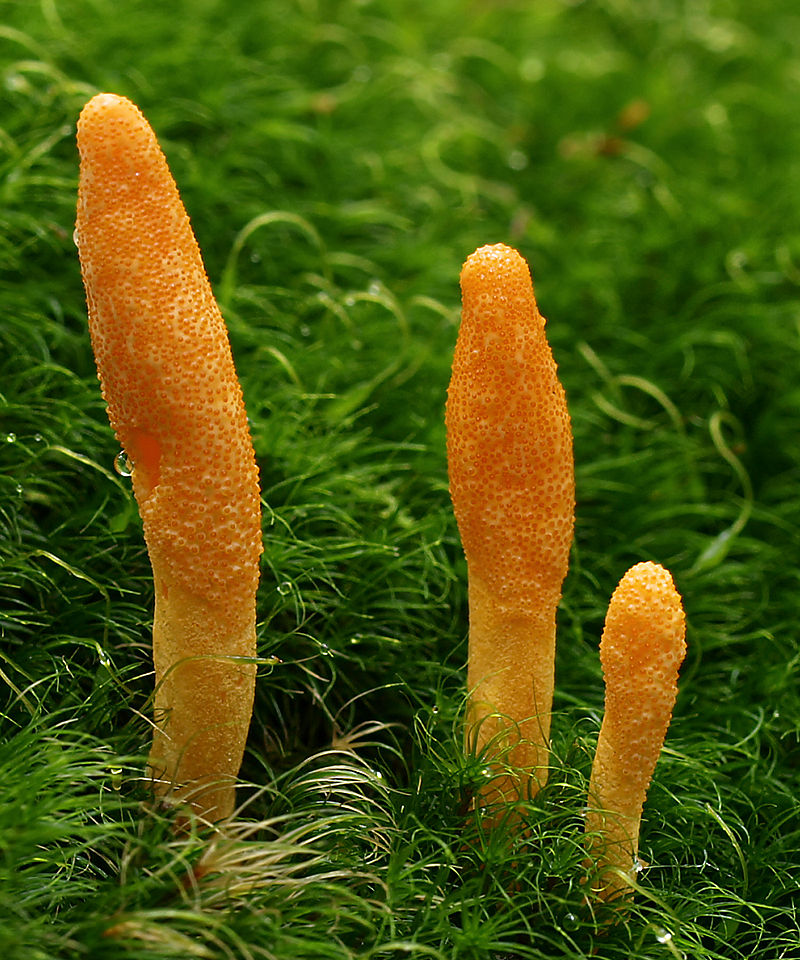Meredith Swann's Lab 4: BLAST, Cordyceps militaris protein
What protein did you search for?
I chose to look for proteins created by any member of the Cordyceps family, and found a paper on a particular protein produced by Cordyceps militaris with possible antifungal and anticancerous properties here. For those unfamiliar, Cordyceps is a fungus known for parasitizing assorted insects, with two of the more well-known species growing in ants and caterpillars. For those of you who have heard of the video game The Last of Us, the zombie plague in that game is supposed to be a mutated strain of Cordyceps.
Very pretty-- when you can't see what it's growing out of! 😉
What specific protein did you select (be careful here – a search for insulin will also give you results for insulin receptors and many other insulin-related molecules)?
Serine cysteine tripsin, accession number ATY67355. The protein referred to as CMP in the paper I mentioned was not given a specific name and was only roughly described as a "trypsin-like serine protease," so it is likely not quite the same one.
What is the amino acid sequence that codes for this protein? Cut and paste from the database and put these search results (or no more than the first 15 typed lines) in your lab report. Translate the first 10 amino acids from this code into the amino acid names.
1 mipdisgtsh lelgaaated gkstkpnkpa pesplasdgl vtwsllgdqk qesikhtihg
61 hdriraieas fdhedkrtpv dlgdfqdggk yrsivriesr wggertapwt igtgwlvred
121 llitaghnvf saahqcqash iqcqlgyrgg sfidesseqy rsalnvvttk swlrqhrdrd
181 rrdlaliqvd kpftgnlrlf kyiqtptskk egtiivvgyp gdehletfvg etslwmcear
241 qkanydldks anhmieynmd iyggqsgapi lfsdhtgtvv igthcysgtg gkvnsgslig
301 geygnkyedf ikrvelskre epyrlggfqp kfahldsyys efsrsggtnd fwaminkvke
361 iglysfgggq sltlgpvgwl mgtiaggmig llsatartes qkryesptwd linacacraq
421 laeaafqcvm rltpseerek vilkmrdywv dhlswlpfdt lsevhllvql spifndfgfr
481 lavsqwqkdi sanpevkplg qeflklprig qirfdkrgdg llwglfgvqs rfvhsvdqkn
541 vesaagwlag vvktaiqvaq pivseaaskd lrrivdamgm gdsgyipipd midqemgwiv
601 kravmadmal qvlenldfev laeltvmprg teresalani rtiiqqigpk pielakismm
661 klfdpiysrl leqkihpkav agsamakade apgephengn ktpahsptvv peiknv
The first ten amino acids are methionine, isoleucine, proline, aspartic acid, isoleucine, serine, glycine, threonine, serine, and histidine.
AUTHORS Kramer,G.J. and Nodwell,J.R.
TITLE Direct Submission
JOURNAL Submitted (07-SEP-2017) Department of Biochemistry, University of
Toronto, MaRS Centre West Tower, 606 University Avenue, Toronto, ON
M5G1M1, Canada
What is the nucleotide sequence that codes for this protein? Cut and paste from the database and put these search results (or no more than the first 15 typed lines) in your post.
I could not find a nucleotide listed for this protein.


Hey Meredith!! I found your post intriguing about how people are still finding different proteins and are doing the research everyday. I didnt know about the fungus and it really did get me thinking about all the populations in the world.
ReplyDeleteHi Meredith. I am really interest with Cordyceps as well. About 2 months ago, a Chinese news report said that Cordyceps cannot work as antifungal or anticancerous. I was surprised and thought it was a fake news. I think scientists are still exploring the components in the Cordyceps. Hope there will have a specific result of its function.
ReplyDelete